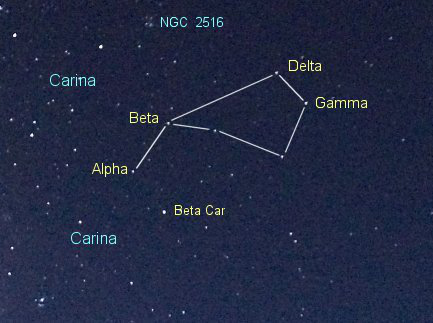by Dave Blane — 2014 January 25
Gamma Volantis is a fine double in the far southern constellation of Volans, the Flying Fish, which is a shortened form of the original name Piscis Volans. Although labelled γ, it is the brightest star in the constellation.

It has coordinates 07h 08m 44s and -70° 29′ 56″. It is only about 20° from the south celestial pole and is thus circumpolar for observers in South Africa and can be observed for most of the year.
It was discovered by Dunlop in 1826 and is number 42 in his catalogue of double stars.
The primary, γ2, has a magnitude of 3.9 and is an orange K-type giant while γ1 is a magnitude 5.4 yellow-white F-tye main sequence star. In the telescope the stars appear as a bright golden and pale yellow pair.
At the time of discovery in 1826 the separation was 15.7″ at a position angle of 303° and there has been some change over the years as the Washington Double Star Catalog gives the separation as 14.4″ and PA 296° in 2002. I measured the pair in 2011 with a 150-mm refractor and Meade Astrometric eyepiece and found the separation to be 14.2″ at a PA of 296°.
This object is a splendid sight in even the smallest telescope and could possibly be resolved with tripod mounted or stabilised binocs. So get out there and make a sketch of what you see in the eyepiece and submit it to the Deep-Sky Section and you could earn an observing certificate!
- Browse the Newsletter Archives.
